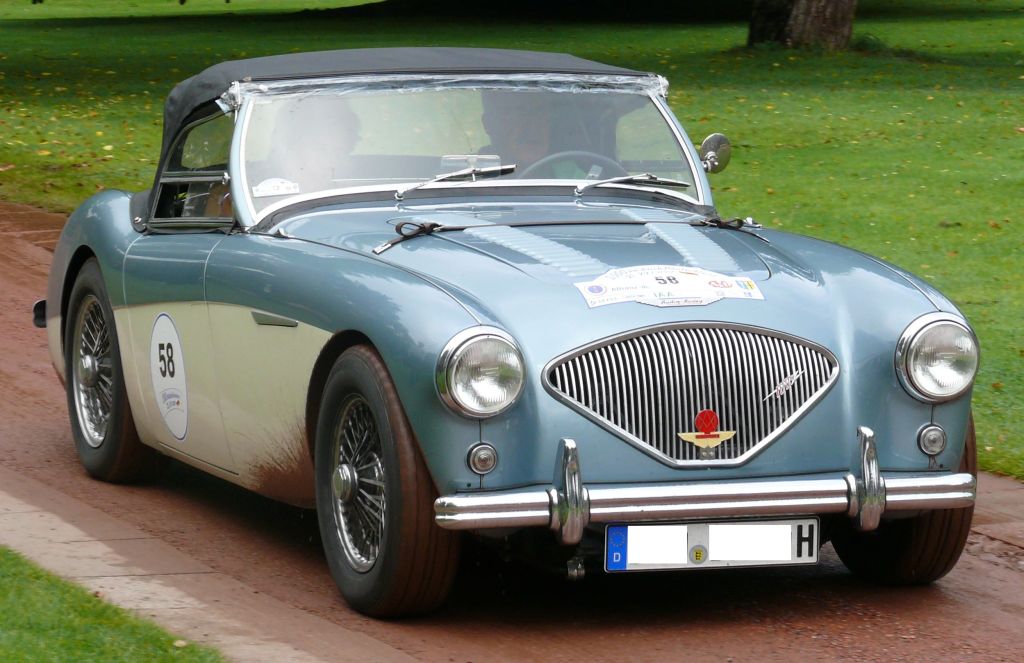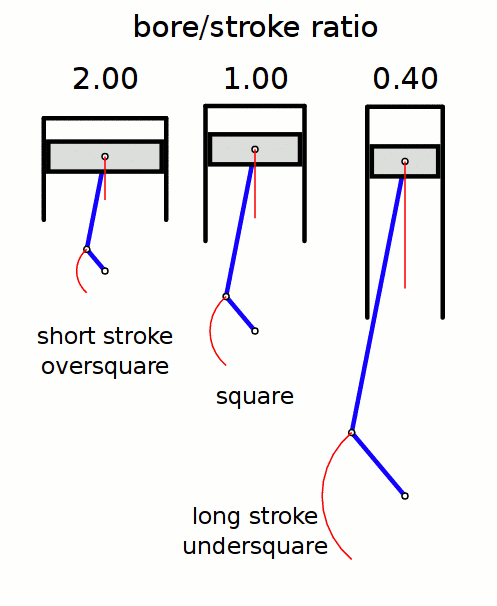|
Austin-Healey 100
The Austin-Healey 100 is a sports car that was built by Austin-Healey from 1953 until 1956. Based on Austin A90 Atlantic mechanicals, it was developed by Donald Healey to be produced in-house by his small Healey car company in Warwick. Healey built a single Healey Hundred for the 1952 London Motor Show, and the design impressed Leonard Lord, managing director of Austin, who was looking for a replacement for the unsuccessful A90. Body styling was by Gerry Coker, the chassis was designed by Barry Bilbie with longitudinal members and cross bracing producing a comparatively stiff structure upon which to mount the body, innovatively welding the front bulkhead to the frame for additional strength. In order to keep the overall vehicle height low the rear axle was underslung, the chassis frame passing under the rear axle assembly. Lord struck a deal with Healey to build it in quantity; bodies made by Jensen Motors were given Austin mechanical components at Austin's Longbridge plant. ... [...More Info...] [...Related Items...] OR: [Wikipedia] [Google] [Baidu] |
Austin-Healey 100-6
The Austin-Healey 100-6 is a two-seat roadster that was announced in late September 1956 and produced from 1956 until 1959. A replacement for the Austin-Healey 100, it was followed by the Austin-Healey 3000; together, the three models have become known as the Big Healeys. The 100-6 featured a longer wheelbase than the 100, a more powerful straight-six engine in place of its slightly larger inline-four, and added two occasional seats (which later became optional). The body lines were slightly streamlined, a smaller, wider radiator grille placed lower, an air scoop was added to the bonnet, and the windscreen fixed. The 100-6 was produced in two model designators, the 2+2 BN4 from 1956 onwards and the 2-seat BN6 in 1958–9. The cars used a tuned version of the BMC C-Series engine previously fitted to the Austin Westminster The Austin Westminster series are large saloon and estate cars that were sold by the British manufacturer Austin from 1954, replacing the A70 Herefo ... [...More Info...] [...Related Items...] OR: [Wikipedia] [Google] [Baidu] |
Big Healeys
Big or BIG may refer to: * Big, of great size or degree Film and television * ''Big'' (film), a 1988 fantasy-comedy film starring Tom Hanks * ''Big!'', a Discovery Channel television show * ''Richard Hammond's Big'', a television show presented by Richard Hammond * ''Big'' (TV series), a 2012 South Korean TV series * ''Banana Island Ghost'', a 2017 fantasy action comedy film Music * '' Big: the musical'', a 1996 musical based on the film * Big Records, a record label * ''Big'' (album), a 2007 album by Macy Gray * "Big" (Dead Letter Circus song) * "Big" (Sneaky Sound System song) * "Big" (Rita Ora and Imanbek song) * "Big", a 1990 song by New Fast Automatic Daffodils * "Big", a 2021 song by Jade Eagleson from ''Honkytonk Revival'' *The Notorious B.I.G., an American rapper Places * Allen Army Airfield (IATA code), Alaska, US * BIG, a VOR navigational beacon at London Biggin Hill Airport * Big River (other), various rivers (and other things) * Big Island (disambigua ... [...More Info...] [...Related Items...] OR: [Wikipedia] [Google] [Baidu] |
Austin-Healey 100S Of Daniel Schlatter
Austin-Healey was a British sports car maker established in 1952 through a joint venture between the Austin division of the British Motor Corporation (BMC) and the Donald Healey Motor Company (Healey), a renowned automotive engineering and design firm. Leonard Lord represented BMC and Donald Healey his firm. BMC merged with Jaguar Cars in 1966 to form British Motor Holdings (BMH). Donald Healey left BMH in 1968 when it merged into British Leyland. Healey then joined Jensen Motors, which had been making bodies for the "big Healeys" since their inception in 1952, and became their chairman in 1972. Austin-Healey cars were produced until 1972 when the 20-year agreement between Healey and Austin came to an end. Models built Austin-Healey 100 ::Open 2-seater (minimal weather protection) * 1953–55 BN1 Austin-Healey 100 * 1955 Austin-Healey 100S (Limited production—50 race-prepared cars) * 1955–56 BN2 Austin-Healey 100 and 100M Austin-Healey 100-6 ::Open 2+2-seater * ... [...More Info...] [...Related Items...] OR: [Wikipedia] [Google] [Baidu] |
British Motor Corporation
The British Motor Corporation Limited (BMC) was a UK-based vehicle manufacturer, formed in early 1952 to give effect to an agreed merger of the Morris and Austin businesses.Morris-Austin Merger Company Named. ''The Times'', Friday, 29 February 1952; pg. 9; Issue 52248 BMC acquired the shares in Morris Motors and the Austin Motor Company. Morris Motors, the holding company of the productive businesses of the Nuffield Organization, owned MG, Riley, and Wolseley. The agreed exchange of shares in Morris or Austin for shares in the new holding company, BMC, became effective in mid-April 1952. In September 1965, BMC took control of its major supplier of bodies, Pressed Steel, acquiring Jaguar's body supplier in the process. In September 1966, BMC absorbed with Jaguar Cars. In December 1966, BMC changed its name to British Motor Holdings Limited (BMH).British Motor Takes That New Label ''The Times'', Thursday, 15 December 1966; pg. 17; Issue 56815 BMH merged, in May 1968, with ... [...More Info...] [...Related Items...] OR: [Wikipedia] [Google] [Baidu] |
British International Motor Show
The British International Motor Show is an annual motor show held by the Society of Motor Manufacturers and Traders between 1903 and 2008 in England, and as The British Motor Show since 2021 by Automotion Events. Initially held in London at The Crystal Palace, Olympia and then the Earls Court Exhibition Centre, it moved to the National Exhibition Centre in Birmingham in 1978, where it stayed until 2004. It was held at ExCeL London in 2006 and 2008 and now based in Farnborough (Hampshire) at the airport exhibition centre. The 2010 and 2012 events were cancelled due to the global financial crisis. Between 2016 and 2019 there were annual motor shows held under the London Motor Show banner. The show returned in 2021 to Farnborough under the banner of The British Motor Show and was the first international motor show event to take place after the lifting of coronavirus measures. The event recorded 45,000 visitors in its first year returning, and proceeded to grow to almost 60,00 ... [...More Info...] [...Related Items...] OR: [Wikipedia] [Google] [Baidu] |
Austin-Healey 100M Silverstone 2007 Cropped
Austin-Healey was a British sports car maker established in 1952 through a joint venture between the Austin division of the British Motor Corporation (BMC) and the Donald Healey Motor Company (Healey), a renowned automotive engineering and design firm. Leonard Lord represented BMC and Donald Healey his firm. BMC merged with Jaguar Cars in 1966 to form British Motor Holdings (BMH). Donald Healey left BMH in 1968 when it merged into British Leyland. Healey then joined Jensen Motors, which had been making bodies for the "big Healeys" since their inception in 1952, and became their chairman in 1972. Austin-Healey cars were produced until 1972 when the 20-year agreement between Healey and Austin came to an end. Models built Austin-Healey 100 ::Open 2-seater (minimal weather protection) * 1953–55 BN1 Austin-Healey 100 * 1955 Austin-Healey 100S (Limited production—50 race-prepared cars) * 1955–56 BN2 Austin-Healey 100 and 100M Austin-Healey 100-6 ::Open 2+2-seater * ... [...More Info...] [...Related Items...] OR: [Wikipedia] [Google] [Baidu] |
Simeone Foundation Automotive Museum
The Simeone Foundation Automotive Museum is an automotive museum located at 6825 Norwitch Drive in Philadelphia, Pennsylvania. The museum's collection consists of approximately 75 racing sports cars and has been assembled over more than 50 years by Frederick A. Simeone, a retired neurosurgeon and native of Philadelphia. Frederick Simeone has been ranked the #1 car collector by the Classic Car Trust Registry. History Frederick Simeone's father was a general practitioner who ran his medical practice out of a rowhouse in the Kensington section of Philadelphia. When his father died in 1972, Simeone was left with $8,000 and 4 cars which were stored in a garage on Clearfield Street. He grew this collection over the next four decades, and in 2008 he donated the entire collection of cars to the museum's foundation, which now owns the titles to the cars. From 1982 until the Museum's opening in June 2008, the cars were stored in a garage near 8th and Lombard Streets in Philadelphia. Dr. Sime ... [...More Info...] [...Related Items...] OR: [Wikipedia] [Google] [Baidu] |
Bonneville Salt Flats
The Bonneville Salt Flats are a densely packed salt pan in Tooele County in northwestern Utah. A remnant of the Pleistocene Lake Bonneville, it is the largest of many salt flats west of the Great Salt Lake. It is public land managed by the Bureau of Land Management and is known for land speed records at the Bonneville Speedway. Access to the Flats is open to the public. The Flats are about 12 miles (19 km) long and 5 miles (8 km) wide, with a crust almost 5 ft (1.5m) thick at the center and less than one inch (2.5 cm) towards the edges. It is estimated to hold 147 million tons of salt, approximately 90% of which is common table salt. History Geologist Grove Karl Gilbert named the area after Benjamin Bonneville, a U.S. Army officer who explored the Intermountain West in the 1830s. In 1907, Bill Rishel and two local businessmen tested the suitability of the salt for driving by taking a Pierce-Arrow onto its surface. A railway line across the Flats was completed in 1910, ma ... [...More Info...] [...Related Items...] OR: [Wikipedia] [Google] [Baidu] |
The Motor (magazine)
''The Motor'' (later, just ''Motor'') was a British weekly car magazine ''Car'' is a British automotive enthusiast magazine published monthly by Bauer Consumer Media. International editions are published by Bauer Automotive in Republic of Korea (since March 2016), Brazil, China, Greece, India, Italy (through 201 ... founded on 28 January 1903 and published by Temple Press. It was initially launched as ''Motorcycling and Motoring'' in 1902 before the title was shortened. From the 14 March 1964 issue the magazine name was simply ''Motor''. Compared to rival ''The Autocar'' (later, just ''Autocar''), ''Motor'' was more informative and more conservative. The magazine usually included: * News and scoops of the latest cars * Motorsport news and results * Car reviews – normally two, both 2 pages long with specifications and impressions. * Road tests – one per week and very detailed In 1988, the journal was absorbed by its long-standing rival '' Autocar'', which became, f ... [...More Info...] [...Related Items...] OR: [Wikipedia] [Google] [Baidu] |
Manual Transmission
A manual transmission (MT), also known as manual gearbox, standard transmission (in Canada, the United Kingdom, and the United States), or stick shift (in the United States), is a multi-speed motor vehicle transmission (mechanics), transmission system, where gear changes require the driver to manually select the gears by operating a gear stick and clutch (which is usually a foot pedal for cars or a hand lever for motorcycles). Early automobiles used ''sliding-mesh'' manual transmissions with up to three forward gear ratios. Since the 1950s, ''constant-mesh'' manual transmissions have become increasingly commonplace and the number of forward ratios has increased to 5-speed and 6-speed manual transmissions for current vehicles. The alternative to a manual transmission is an automatic transmission; common types of automatic transmissions are the Automatic transmission#Hydraulic automatic transmissions, hydraulic automatic transmission (AT), and the continuously variable transmissio ... [...More Info...] [...Related Items...] OR: [Wikipedia] [Google] [Baidu] |
Undersquare
In a reciprocating piston engine, the stroke ratio, defined by either bore/stroke ratio or stroke/bore ratio, is a term to describe the ratio between cylinder bore diameter and piston stroke length. This can be used for either an internal combustion engine, where the fuel is burned within the cylinders of the engine, or external combustion engine, such as a steam engine, where the combustion of the fuel takes place ''outside'' the working cylinders of the engine. A fairly comprehensive yet understandable study of stroke/bore effects was published in ''Horseless Age'', 1916. Conventions In a piston engine, there are two different ways of describing the ''stroke ratio'' of its cylinders, namely: ''bore/stroke'' ratio, and ''stroke/bore'' ratio. Bore/stroke ratio Bore/stroke is the more commonly used term, with usage in North America, Europe, United Kingdom, Asia, and Australia. The diameter of the cylinder bore is divided by the length of the piston stroke to give the ratio. ... [...More Info...] [...Related Items...] OR: [Wikipedia] [Google] [Baidu] |



_(21536272268).jpg)




